Calvary Cemetery, Queens, New York (Part 1)
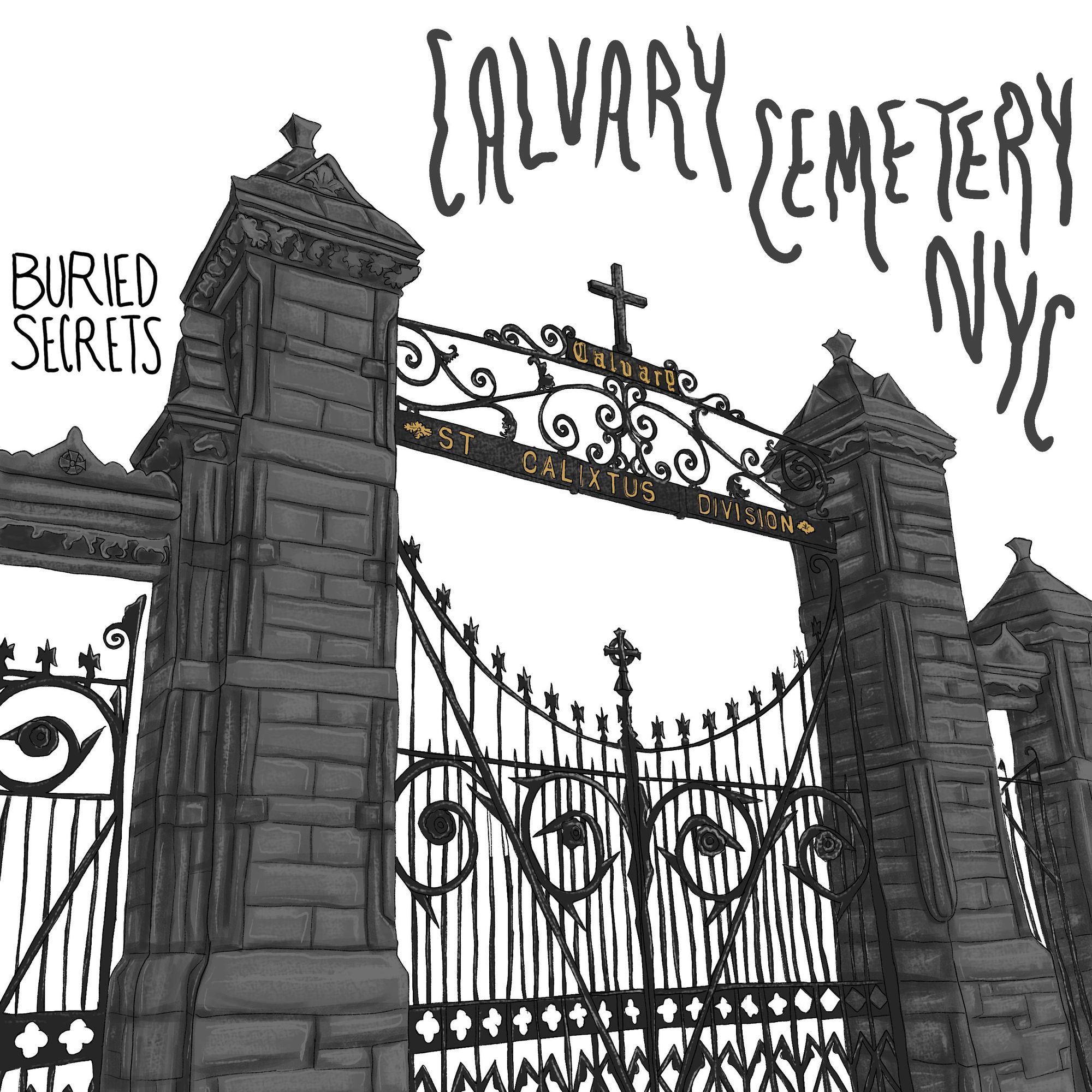
More people are buried at Calvary Cemetery, in Queens, New York, than in any other cemetery in the United States.
“Calvary Cemetery is by far the most important burial ground in the vicinity of New York, and, in fact, in the United States in point of interments, extent, and the number of monuments and headstones that go to make it a wilderness of rising tombstones.”
-The Leonard Manual of the Cemeteries of New York and Vicinity, 1901
This episode is focused on the history of the cemetery, what it’s like to visit it nowadays, and some of the most interesting people buried there.
Highlights include:
• The Cemetery Belt, a collection of NYC cemeteries that can be seen from space
• A rich man who died in a barn
• A Black, queer communist author and poet
• Rome’s ancient catacombs
• Some NYC mobsters
• A female author who grew up in a castle
• A NYC cop who was assassinated in Sicily
For more audio about Calvary Cemetery, check out our patreon.
Photos taken in and around Calvary Cemetery, Queens, in April and May 2020
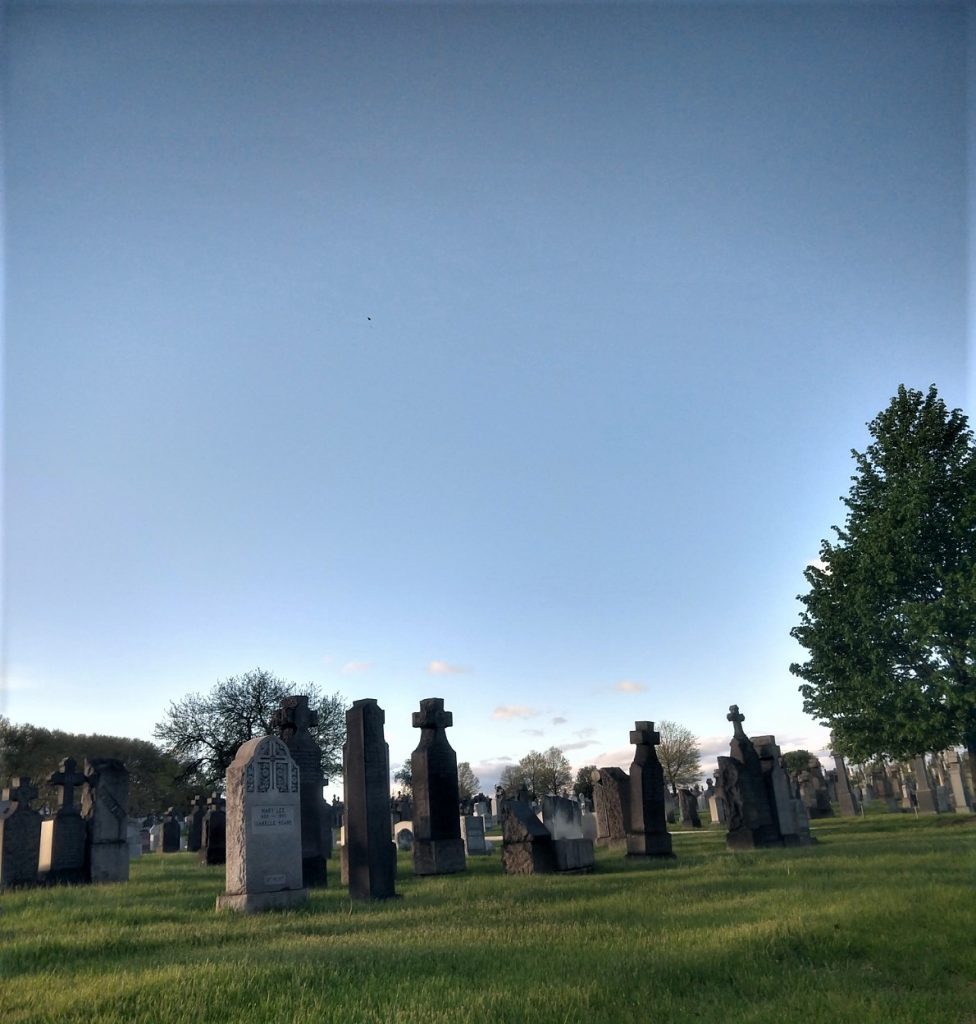
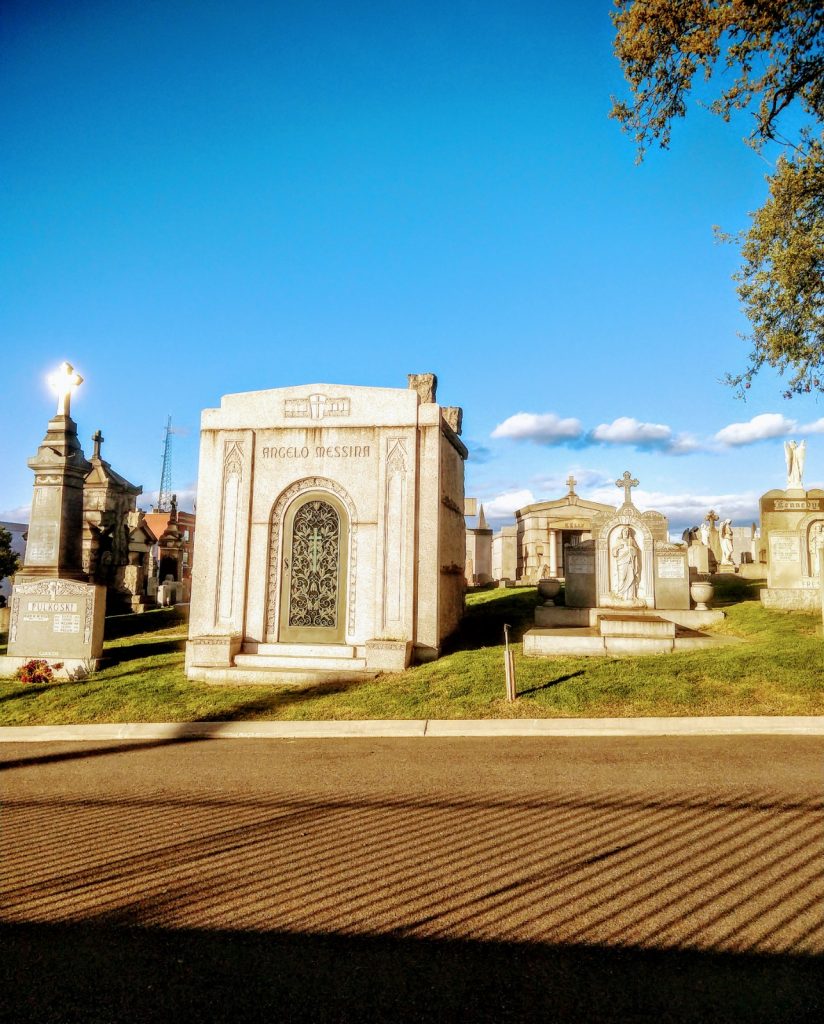
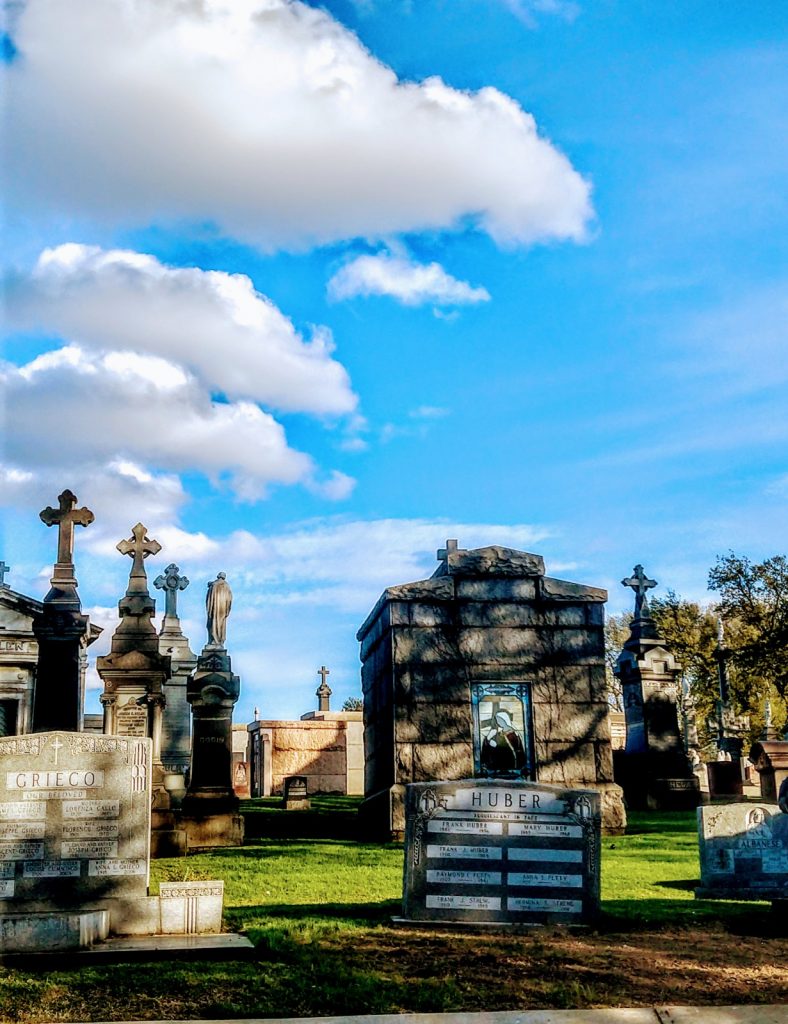
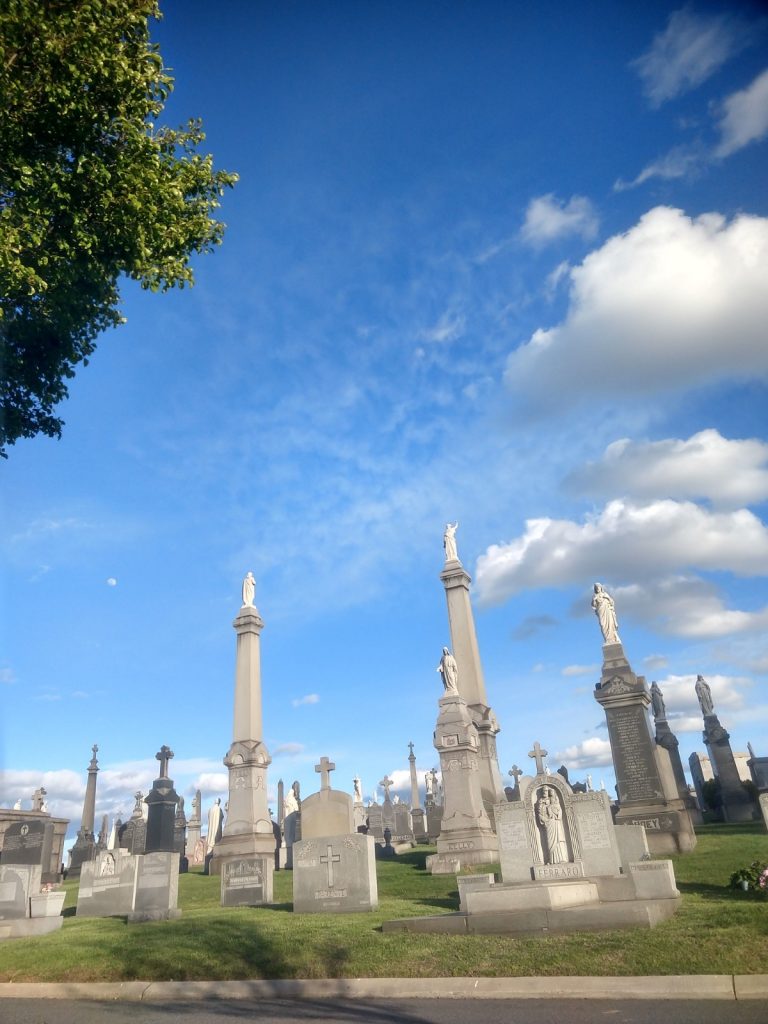
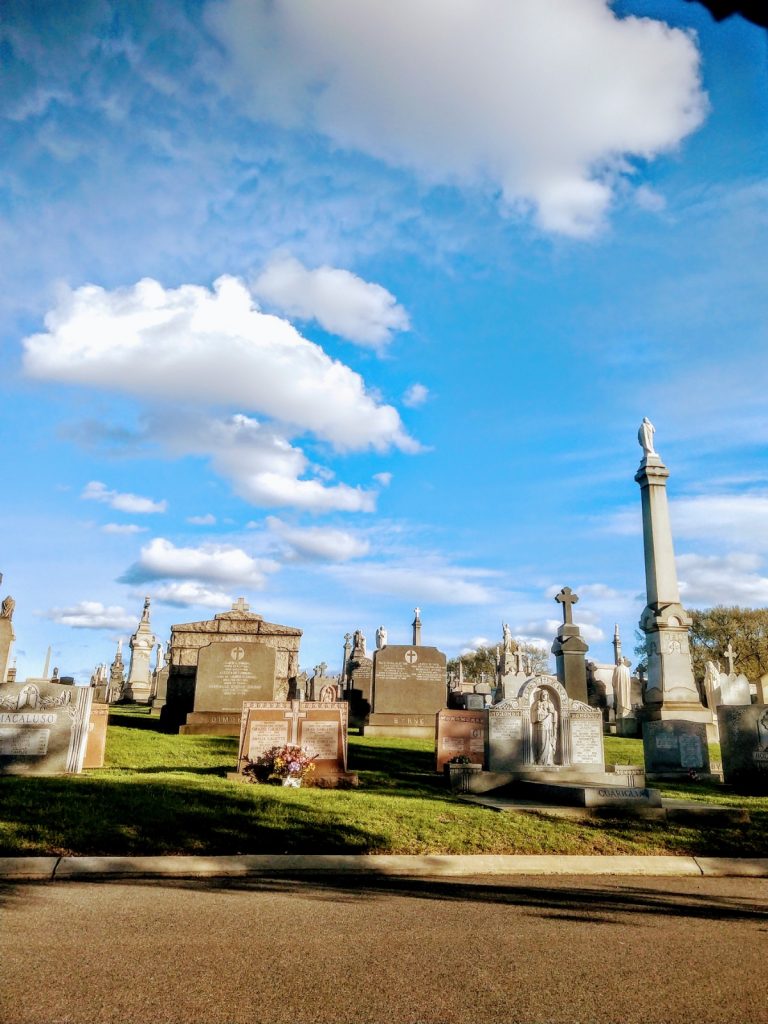
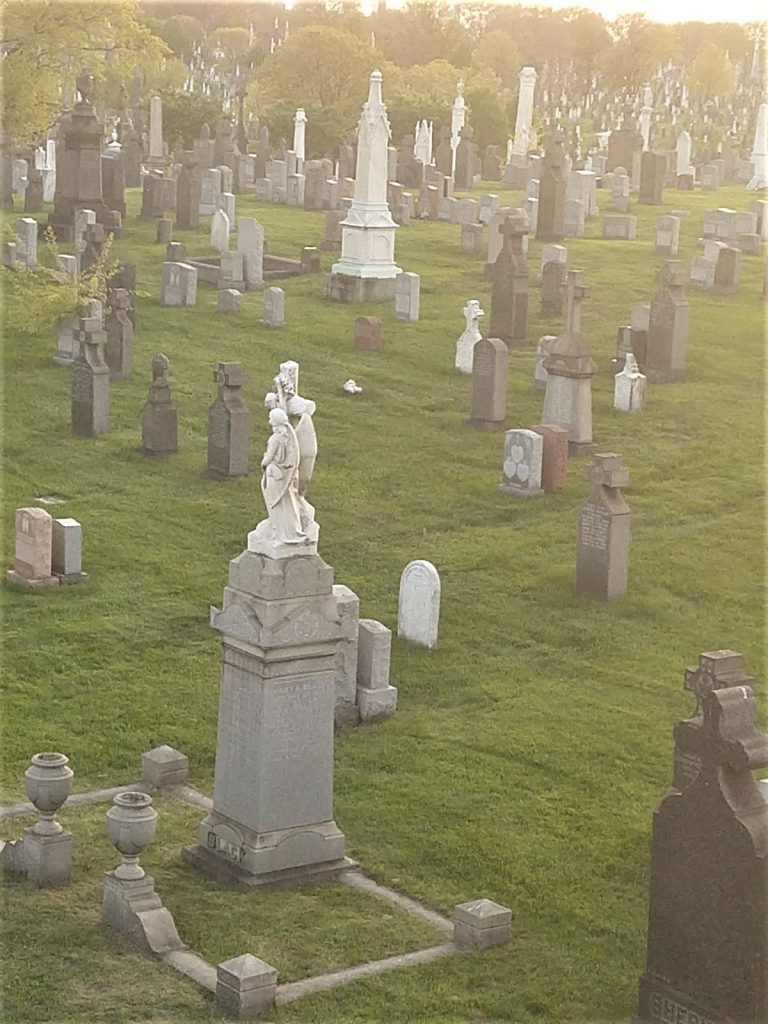
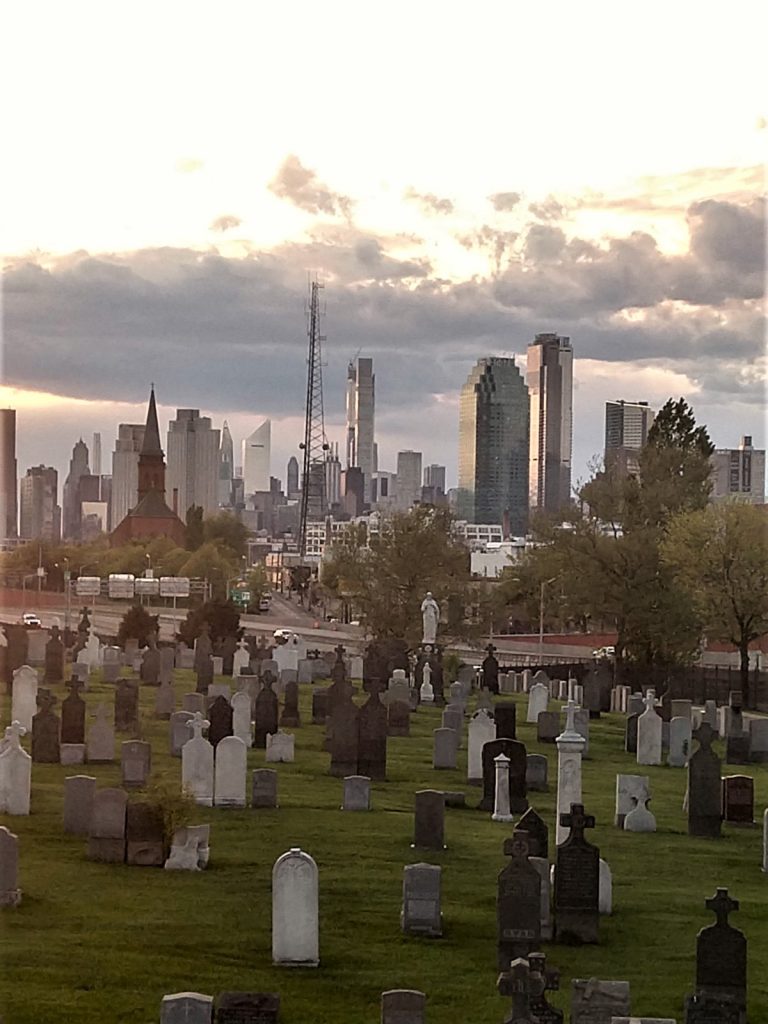
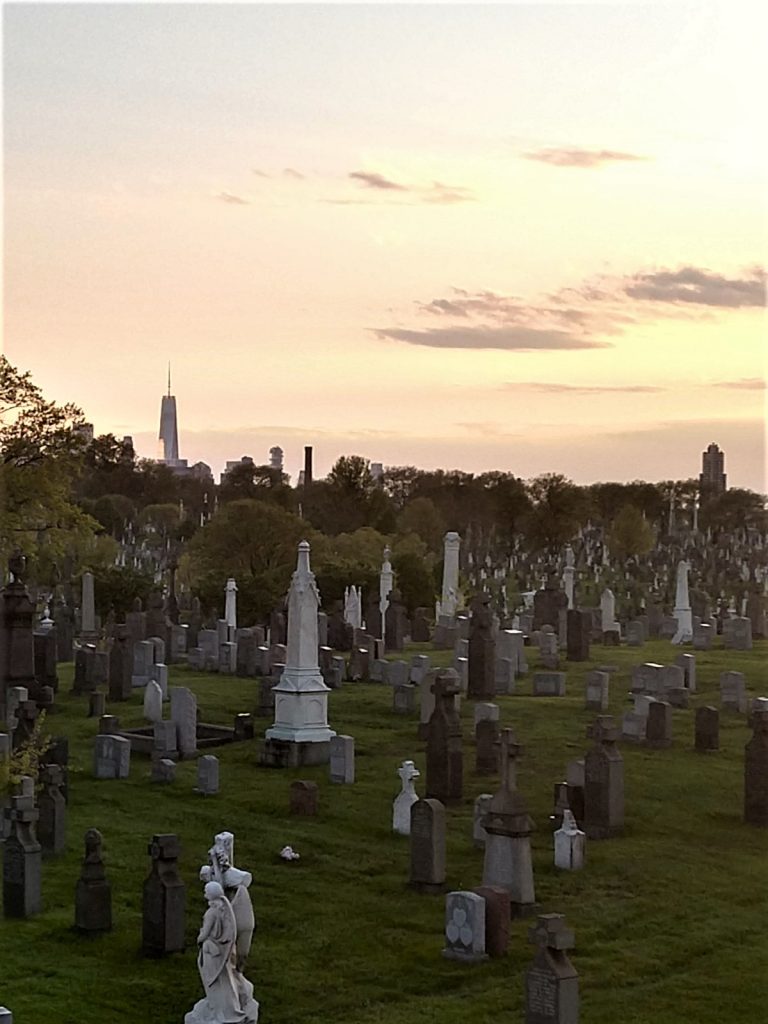
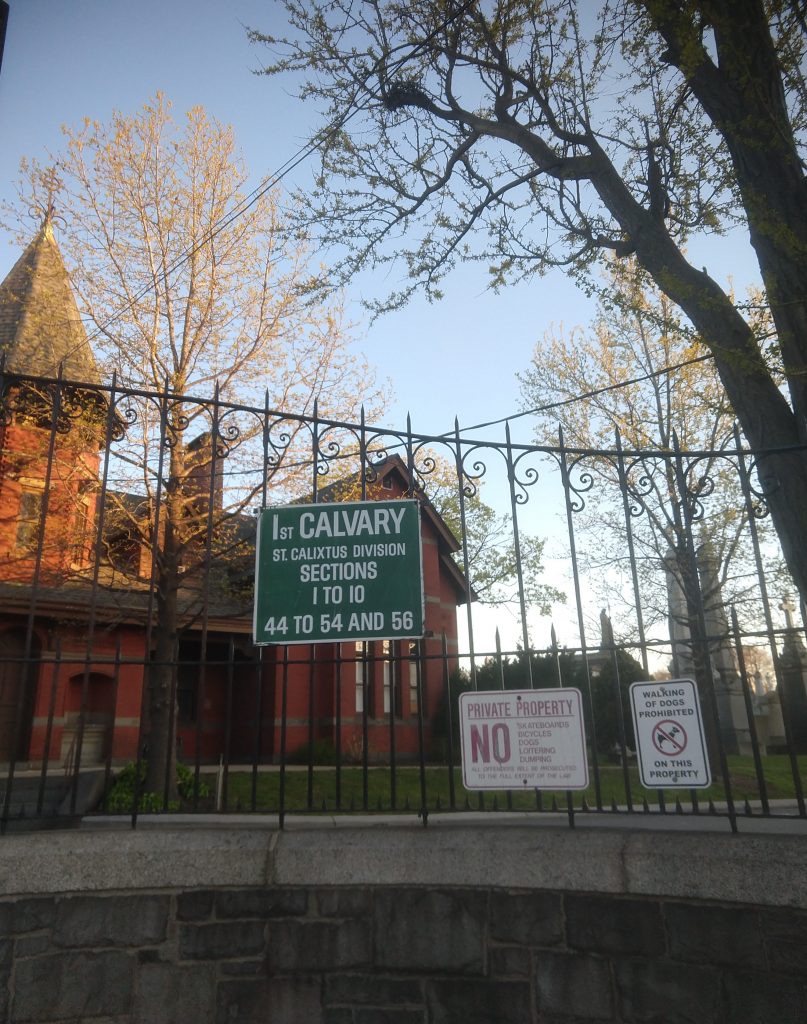
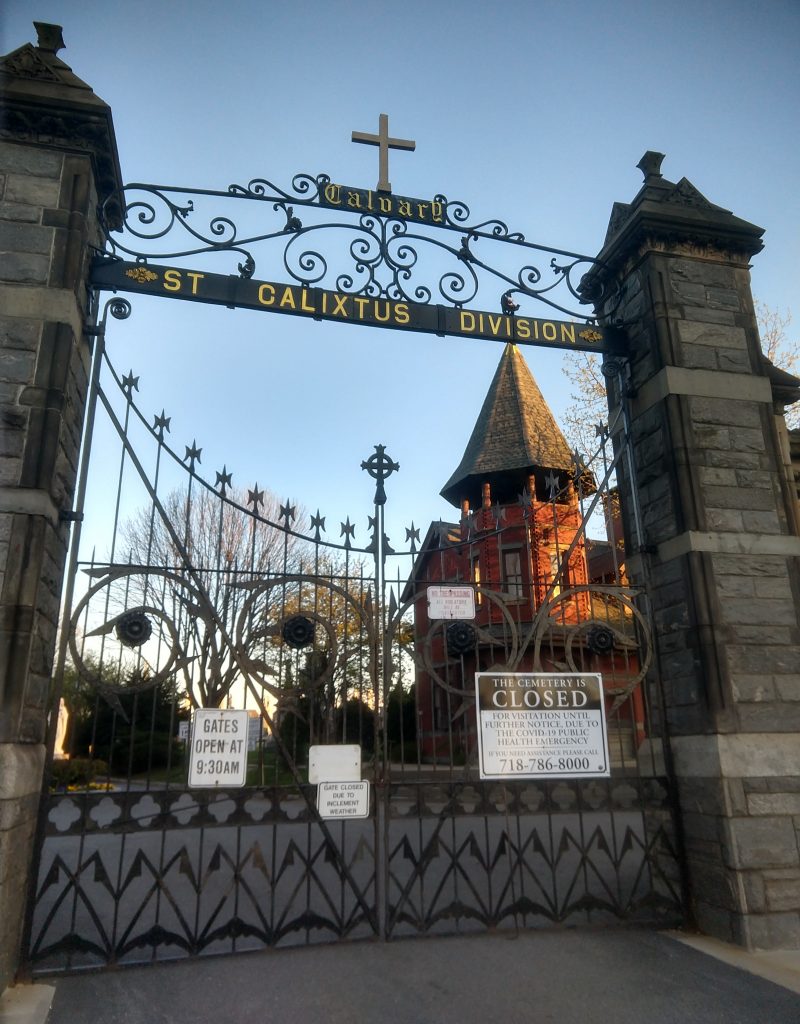
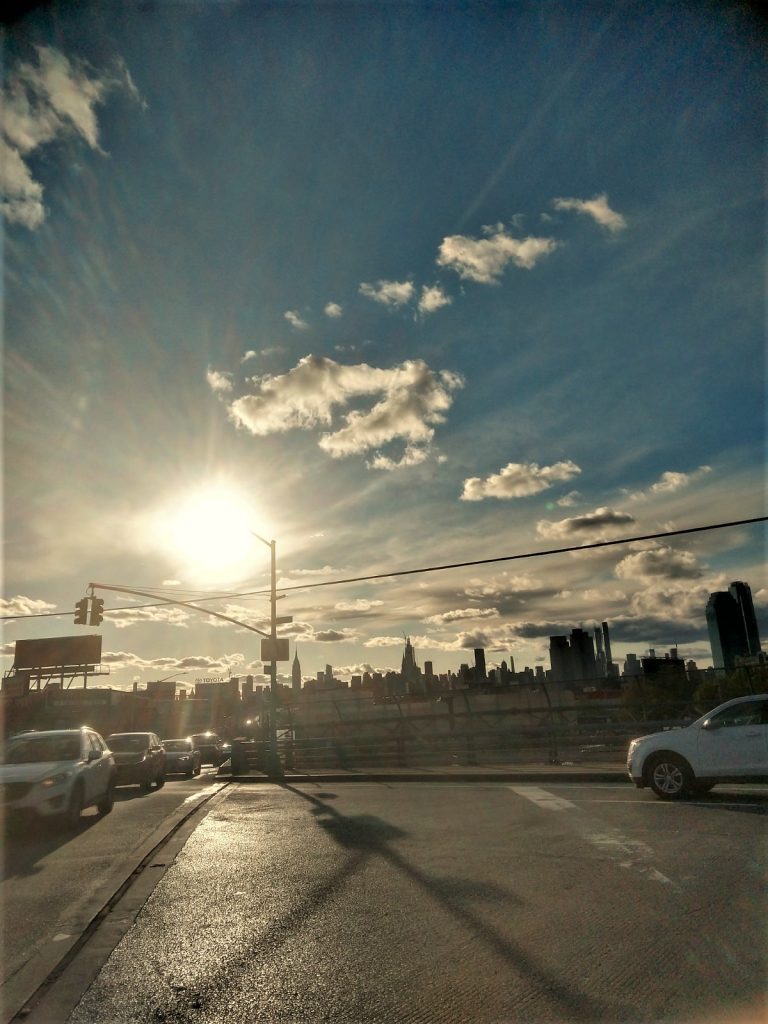
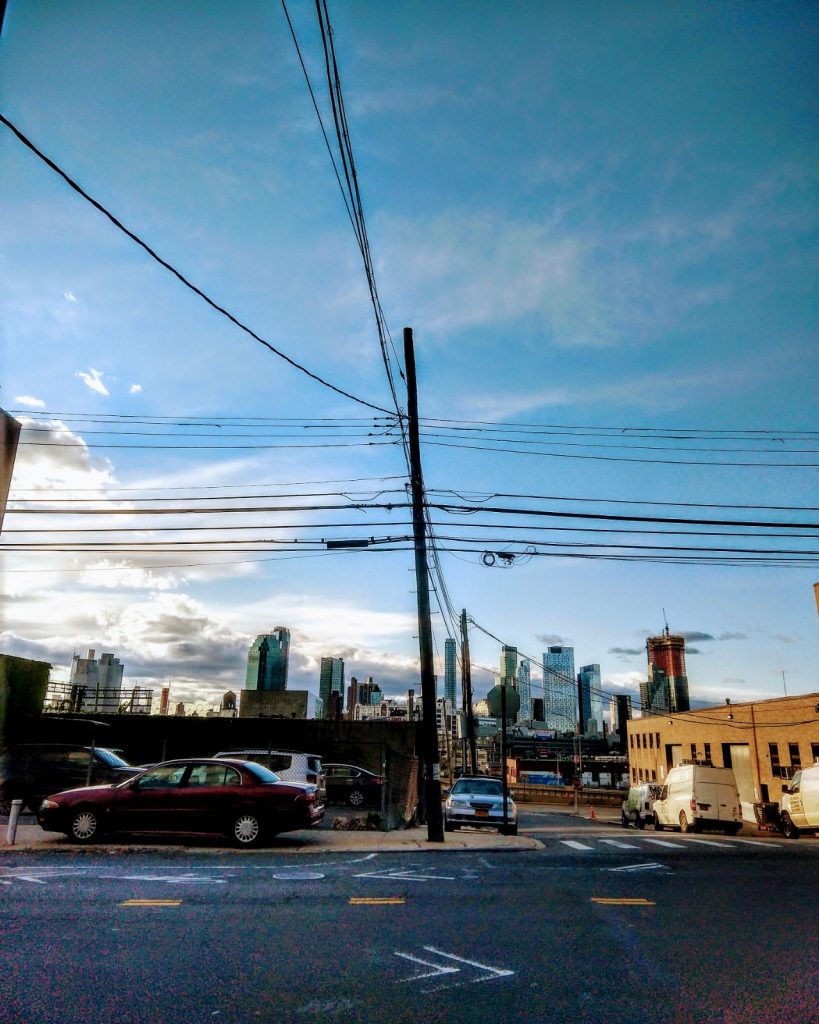
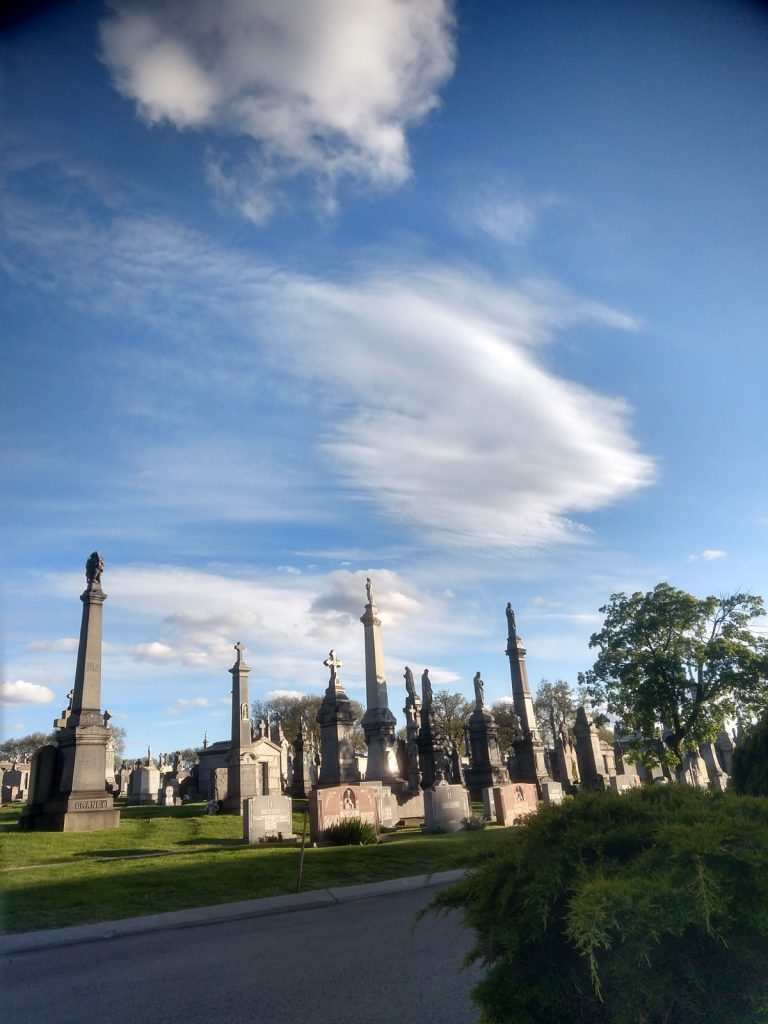
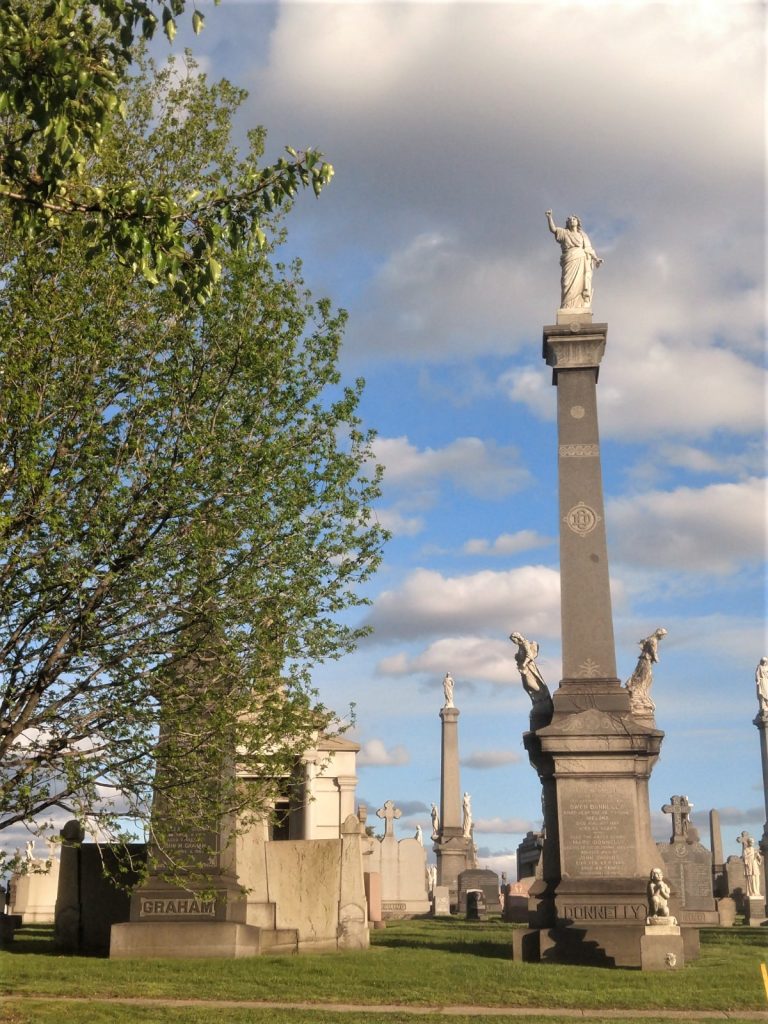
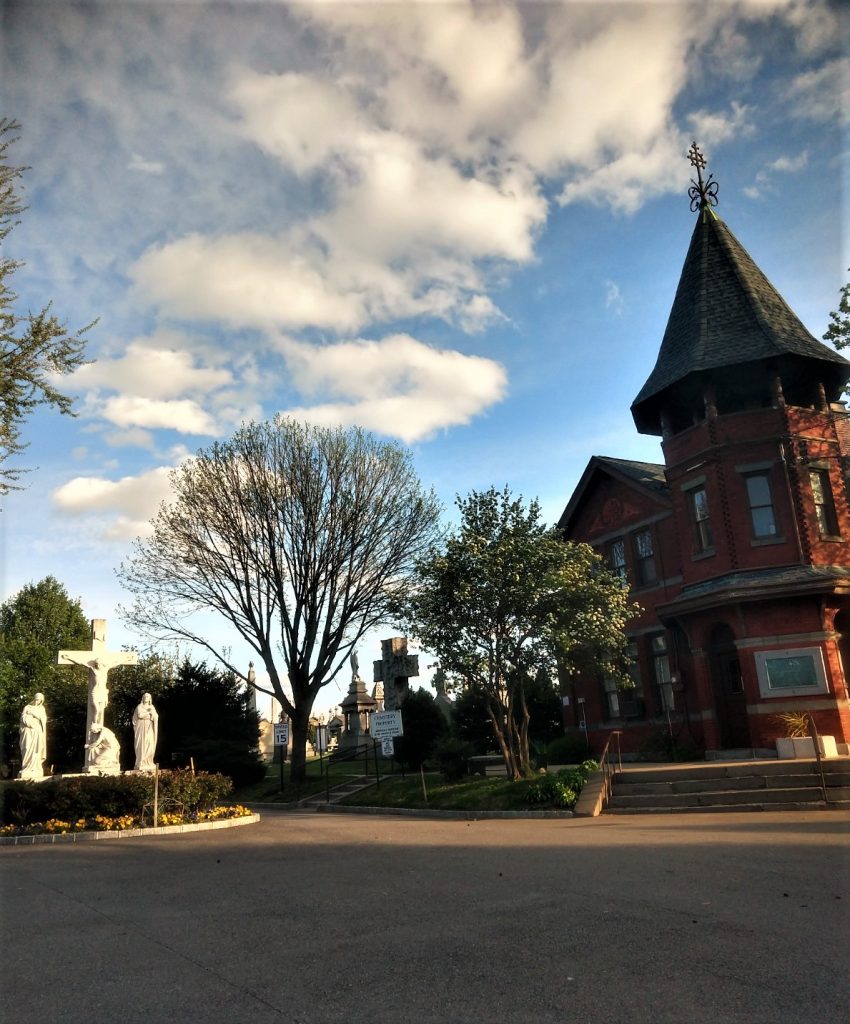
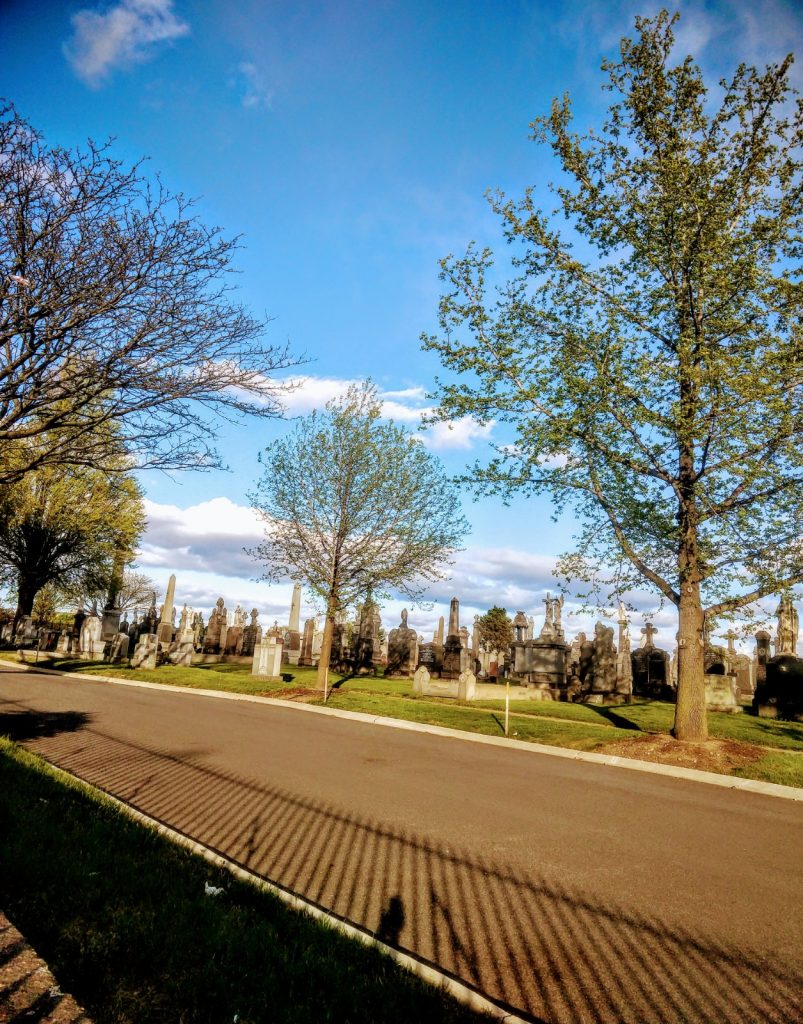
Episode Script for Calvary Cemetery, Queens, New York (Part 1)
DISCLAIMER: I’m providing this version of the script for accessibility purposes. It hasn’t been proofread, so please excuse typos. There are also some things that may differ between the final episode and this draft script. Please treat the episode audio as the final product.
“Calvary Cemetery is by far the most important burial ground in the vicinity of New York, and, in fact, in the United States in point of interments, extent, and the number of monuments and headstones that go to make it a wilderness of rising tombstones.” –The Leonard Manual of the Cemeteries of New York and Vicinity, 1901
“Calvary Cemetery is by far the most important burial ground in the vicinity of New York, and, in fact, in the United States in point of interments . . . and the number of monuments and headstones that go to make it a wilderness of rising tombstones.” –The Leonard Manual of the Cemeteries of New York and Vicinity, 1901
- Did you know that there are more dead people in Queens than living people?
- Did you know that there are more people buried in a single cemetery in Queens than there are living ppl in Queens?
- 2.3 million people live in Queens
- 3 million ppl are buried in Calvary Cemetery–more people than at any cemetery in the US
- I’ve gone to Calvary Cemetery a few times since the pandemic started–or at least I’ve looked in from outside the locked gates. I recorded some audio that’s on our patreon on one trip there in April I believe, though while we’ve been in NC, the cemetery has reopened. So I’m excited go actually go inside once I’m done quarantining.
- So let’s talk about the cemetery’s history:
- The Rural Cemetery Act, which was passed in NY in 1847, allowed commercial burial grounds in rural NYS.
- This had a few effects:
- Burials became a business (before, people were mostly buried at churches and privately owned land)
- “Rural” areas like Queens and Brooklyn started becoming popular places to build cemeteries.
- It also created what’s called The Cemetery Belt nowadays, which is a bunch of cemeteries that exist on the border of Queens and Brooklyn. Apparently it’s large enough to see from space.
- This had a few effects:
- The act was a good idea, since Manhattan’s churchyards were getting crowded, especially because of the outbreaks of cholera.
- Specifically, in 1832, 3,500 people in NYC died in a cholera outbreak, and tons of people left the city.
- There was also concern that burying people in Manhattan was contaminating the drinking water.
- It led to the establishment of many beautiful garden cemeteries, like Woodlawn Cemetery in the Bronx and Mt. Olivet Cemetery in Queens.
- People would flock to these cemeteries on the weekends to enjoy their rolling hills and beautiful trees and flowers.
- Calvary Cemetery was very much not a garden cemetery.
- Even calling it a lawn cemetery feels charitable to me–it’s jam packed with tombstones that always make me think of a shark’s teeth. You know how shark’s teeth kinda grow in lots of uneven rows.
- Specifically, in 1832, 3,500 people in NYC died in a cholera outbreak, and tons of people left the city.
- Calvary Cemetery is run by the Catholic church, specifically the trustees of St. Patrick’s Cathedral, who had started buying up land for Calvary Cemetery in 1846. As early as 1817, they’d realized that their cemetery in Manhattan was filling up.
- The land they purchased was in southern Queens, near the Newtown Creek that forms the border with Brooklyn. I’ve heard the area referred to as Maspeth, or Woodside, or Sunnyside, or an area of Long Island City called Blissville.
- They purchased 71 acres of land–or maybe 115?
- The land they purchased included the Alsop family farm and their family cemetery plot.
- The Alsop family tombstones are still there; the oldest is from 1718
- The new cemetery was named Calvary Cemetery, named after Mount Calvary, which was the hill where Jesus was crucified.
- On July 31, 1848, the first person was buried in the cemetery. Her name was Esther Ennis, and she died at the age of 29, reportedly of a broken heart.
- In August 1848, the cemetery was consecrated by Archbishop John Hughes
- So I just want to pause here two talk about a synchronicity that I enjoy: So I went to Fordham University, which is a Jesuit school in the Bronx, which was founded by Archbishop John Hughes (the school was even originally called St. John’s College, until it was later renamed). And coincidentally, the dorm I lived in freshman year, which started out as a residence for priests and seminarians, was built in 1848.
- When I found out that synchronicity in the spring it really tickled me, though of course it makes sense that the famous, or infamous, John Hughes had a hand in founding both.
- So we’ll be talking all about Archbishop John Hughes, aka Dagger John, next time.
- But to get back to the cemetery itself:
- Hughes consecrated it in 1848, and by 1852, 50 people were buried there every day.
- About half of the burials were poor Irish children younger than 7 years old
- In 1867, the cemetery was full. So they opened additional sections, calling the original section First Calvary or Old Calvary
- Between 1848 and 1898, almost 645K people were buried in Calvary cemetery
- And from 1898 to 1907, 200K people were buried there
- There are now 4 sections of Calvary, which also bear the names of roman catacombs. Some of the catacombs in Rome are as old as 2nd century AD; apparently they came about because there was a land shortage in Rome, so early Christians, as well as Jewish people, buried their dead in the underground catacombs.
- So the 4 sections of Calvary are:
- First Calvary, also called St. Calixtus, was established in 1848,
- St. Calixtus was a pope from 217-222, who was martyred by being thrown down a well by the Roman Empire, who didn’t like Catholics
- Before becoming Pope, his predecessor, Pope Zephyrinus, made him administrator of the preeminent church cemetery, where church leaders and martyrs were buried.
- So he’s the patron saint of cemetery workers.
- The Catacombs of St. Callixtus in Rome house a number of 3rd-century popes, as well as the crypt of St. Cecilia, who gained a cult following in the middle ages
- St. Calixtus was a pope from 217-222, who was martyred by being thrown down a well by the Roman Empire, who didn’t like Catholics
- Second Calvary, aka St. Agnes, acquired in 1888, is named after a catacomb where the young Roman martyr, St. Agnes, was buried.
- To give the backstory of the Roman catacomb:
- Agnes was 12 when she died, and was both burned and decapitated, though some people said the veins in her neck were just severed.
- She became a popular figure right after she died. Many people began to venerate her and visit her tomb.
- Emperor Constantine’s family got really into her, and the emperor’s daughter, Constantina, built a big church nearby because she wanted to be buried near St. Agnes. She built a fancy cylindrical mausoleum, which featured a dome decorated with mosaics featuring cupids gathering grapes. That church is pretty much gone today, aside from the ruins of some masonry.
- Apparently the Catacombs of St. Agnes are badly preserved because they’ve been constantly visited basically from the time she died.
- To give the backstory of the Roman catacomb:
- Third Calvary, aka St. Sebastian, established in 1879
- The roman catacombs that it’s named after was somewhere where people would go to venerate the Apostles Peter and Paul
- St. Sebastian is buried there, of course
- And apparently in the middle ages, it was a popular destination for people to visit
- Fourth Calvary, aka St. Domitilla, established in 1900
- The roman catacombs of Domatilla, is built on the site of property owned by a noblewoman named Flavia Domitilla, who was exciled to the Pontine Islands because of her Christian sympathies. Before she left, she gave her possessions to the Christian community there, which led to the largest Christian underground cemetery in Rome being built there
- Back to Calvary:
- By the early 20th century, the flu and TB were major epidemics, so there was a shortage of gravediggers, and families had to dig graves for their deceased relatives themselves
- Adults could be buried there in $7, children younger than 7 cost $3, and children aged 7-14 cost $5
- As Manhattan’s East Village was developed more and more, many people were dug up from cemeteries there and moved to Calvary Cemetery so they could build more
- People reached the cemetery by ferry
- The boat left from 23rd street in Manhattan, and later 10th street
- Initially, there was a simple frame chapel in Calvary Cemetery, but in 1908, they built a chapel that was inspired by the Sacré-Cœur Basilica in Paris and looks a lot like it
- To read from a 1909 article in Popular Mechanics:
- Calvary, the chief Catholic burial ground of Greater New York, has . . . A greater population than any other city of the dead in America, and its new chapel, the only one of the kind in this country, has several features which make it unique in construction and design.
- To read from a 1909 article in Popular Mechanics:
- The building took 3 years to build and cost $180,000 ($50,000 of which was just for the sculptures and furnishings)
- It was designed by a brooklyn architect named Raymond F. Almirall, who studied a bunch of old Italian churches and mortuary chapels
- The building has rubble masonry with Indiana limestone facing
- The dome is 80 ft from the ground and topped with a statue of Jesus that’s carved from a single piece of limestone
- Apparently the dome was very impressive from an arhitectural standpoint, because it was made of reinforced concrete and that took some inventiveness. It’s lined with “golden yellow brick and . . . Pink Minnesota sandstone trimmings” that are attached to the concrete.
- The idea was that priests would be buried in the catacombs, and as of 1909, only one section of the catacombs, which had space for 24 people, was ready. Then the idea was that the section could extend underground in four directions, and they could make space for and additional 72 bodies.
- The chapel has a lift that was set into the floor to lower bodies down to the cripts
- At the time, there were about 70-120 burials a day, so the article noted that the chapel would be in “almost constant use”
- To read a bit more of the article:
- The structure is consequently designed so that one funeral party can depart to the burial plot without interfering with the next cortege waiting in front of the chapel.
- So I wanted to talk a bit about some of the people who’re buried in Calvary Cemetery:
- As far as I can tell, the most famous person buried there is Dom Deluise. But let’s look at some other folks:
- Rosemary Muscarella Ardolina wrote a book called Old Calvary Cemetery: New Yorkers Carved in Stone and examined 5,300 tombstones with legible places of birth listed
- interestingly but not surprisingly 90% of the headstones cite Irish places of birth
- though other common birthplaces were the United States, Italy, France, Scotland and Canada
- The largest personal mausoleum in the cemetery is the Johnson Mausoleum, which was built in the 19th century and cost $100,000 to build (or $2.5 million in today’s dollars). Though I’ve read elsewhere that it cost $300,000 to build
- The Johnsons were a set of brothers–Charles, John, and Robert. John opened J.C. Johnson Department Stores on 22nd Street between Broadway and 5th Avenue (so near where the Flatiron is today) and Charles helped him run the buisiness.
- They were Irish immigrants who ended up becoming millionaires. Silk fabrics were a bestselling item at their department store, which is notable because apparently other similar stores weren’t doing well back then.
- John was really involved in St. Patrick’s church, and was known as a generous donor. When he died in 1887, 7 years after Charles did, he had a big funeral and was put into the mauseleum, where Charles was.
- It’s unclear what exactly happened, but a year after John died, the store, under Robert’s management, went under.
- He retreated to the family mansion on Mt. St Vincent, on the Hudson, and lived there until the house was foreclosed on.
- Then there was a fire, which he apparently barely escaped.
- He went to live in the barn, which was on the property.
- In the winter, some friends came to visit and found him there. Apparently he had pneumonia, and seemed to have gone crazy.
- Ten days later, he died and was buried in the mausleum, which luckily had been paid for already.
- The mausoleum has 30 vaults, but only 6 of them are occupied
- So that’s the Johnson family. The cemetery also holds many Civil War Medal of Honor recipients, particularly soldiers of Irish heritage.
- There’s actually a NYC park inside the cemetery–in 1863, NYC bought a bit of land in the middle of the cemetery from the Trustees of St. Patrick’s Cathedral.
- The city used it to bury Union soldiers who died while in NY hospitals after fighting in the war. 21 soldiers were buried there.
- There’s a big monument featuring an obelisk and four life-sized bronze soldiers
- There are also a number of politicians buried there, including folks involved in Tammany Hall.
- A number of mobsters are buried in Calvary, though apparently many of their graves are unmarked.
- The Terranova brothers, who were part of the Morello crime family around the turn of the 20th century, are there in unmarked graves
- Many 20th century mobsters are buried there, including Johnny Dolan
- I looked him up, and found this interesting tidbit on wikipedia
- Dolan was known as a particularly inventive criminal, who perfected a variety of devices widely used for assault and murder throughout the underworld. According to Asbury, Dolan designed a copper eye gouger to be worn on the thumb and used it both in criminal activities and in battles with other gangs. Dolan himself allegedly owned a personally designed pair of boots with sections of a sharp axe blade embedded in the soles, which he used to stomp a downed victim.
- I will say that the veracity of the descriptions of his violent nature is debated, since one biographer reported it but contemporary newspapers didn’t.
- Instead, they described him as a petty thief.
- He did serve a stint in Blackwell’s Island Penetentiary, which we talked about in the Renwick Smallpox Hospital episode
- He ended up being executed for a murder commited during a robbery, and he was hanged in 1876, when he was 26, in the Tombs Prison, which we talked about in the Victorian Egyptomania episode. It was an ill-fated Egyptian revival building that was constructed on quicksand.
- I looked him up, and found this interesting tidbit on wikipedia
- Giuseppe “Joe the Boss” Masseria who apparently was one of the mafia’s “Boss of All Bosses” lies in Calvary–he led the most powerful NYC organized crime family during prohibition.
- Nowadays, he led the Morello crime family, which is now the Genovese family.
- In 1930, a war between families started, called the Castellammarese War, and it ended with Joe the Boss being killed by his own lieutenant, who shot him in the back in a restaurant where he’d been playing cards in Coney Island, Brooklyn.
- If you want to know more about him, there’s a good blog post on the Newtown Pentacle about him, which I’ll include in the shownotes
- And this isn’t a real burial, but in the movie The Godfather, Don Corleone was buried at Calvary Cemetery
- Though there are many mobsters buried in the cemetery, there’s also obviously a number of cops buried there. And I wanted to share this interesting story about one of them, a cop named Joseph Petrosino.
- A disclaimer: I’m not a fan of the NYPD, but this story was too good not to share.
- Like many of the people buried at Calvary, he was an immigrant. He was from Palermo, Sicily.
- When he was a kid, he and his cousin came to the US to live with the grandfather, who ended up dying in a streetcar accident.
- Since they had no other family in America, they ended up in orphans/surrogates court
- But the judge took pity on them and instead of sending them to an orphanage, he took the boys home to live with his own family while their family was contacted in Italy.
- Because of this, the boys ended up living with a politically connected Irish family for a while, which opened up educational and occupational opportunities that they wouldn’t have gotten otherwise, as recent Italian immigrants
- He joined the NYPD in 1883, and was the first person in the history of NYPD to speak Italian
- He was 5’3″ and had to get a special waiver to get around the NYPD’s height requirement
- He was considered a whiz at solving crimes in the Italian community, so he was sent out anytime a serious crime happened
- He was friends with Teddy Roosevelt, who was part of the council of police commissioners that oversaw the NYPD
- In 1908, Petrosino was made head of the “Italian Squad,” which wikipedia describes as “an elite corps of Italian-Ameriacn detectives assembled specifically to deal with the criminal activities of organizations like the Mafia, which Petrosino saw as a shame upon decent Italians and Italian Americans.”
- As part of the Italian Squad, Petrosino helped out an Italian opera singer named Enrico Caruso, who performed at the Metropolitan Opera at the time. He was being extorted by Black Hang gangers; Black Hand was an Italian extortion racket. Petrosino was an opera lover, and he convinced Caruso to help him catch the blackmailers
- Petrosino also infiltrated an Italian anarchist organization that was maybe connectcted to the assassination of the king of Italy, Umberto I, in 1900.
- Petrosino discovered that the organization planned to assistant President William McKinley during his trip to Buffalo, NY
- Petrosino warned the secret service, and Roosevelt, who was VP at the time, said that they should listen to him. However, McKinley went to Buffalo, NY, during the World’s Fair in September 1901, and was assassinated
- Around 1909, new US law was passed, allowing the US government to deport anyone who’d been convicted of a crime in another country, if they’d been in the US for less than 3 years
- So Petrosino went to Palermo, Sicily, on a secret mission to get evidence of criminals in NYC who’d committed crimes back in Sicily
- It sounds like he shouldn’t have gone–even before he left, newspapers printed anyonymous sources who said why he was going to italy, and people said that he’d be recognized since he was so well known
- In Rome, he saw a criminal he recognized from NYC following him, and it sounds like he’d given his associates in the Black Hand Society a heads up that Petrosino was in Italy
- When he reached Palermo, Petrosino met up with an informant, who claimed to have info on mafia members, in the middle of the night. While waiting for the informant, Petrosino was shot in the face by two people.
- He died there, and after funeral rites happened in Palermo, his body was sent to NYC, where more funeral rites were performed at St. Patrick’s Cathedral. 200,000 people participated in the funeral procession, and NYC declared the day he was buried a city-wide holiday so people could pay their respects
- He was buried in Calvary Cemetery, where a pillar with a bust mark his grave
- I wanted to talk about a couple writers who were buried there: The first is Mary Letitia Martin
- She was an Irish writer who published three books
- She was born into a wealthy family that was the main landowner in Connemara (which is a region of Galway)
- She knew Irish, English, French and supposedly some other languages too
- In 1834, she met a Polish Count, Count Adolphe de Werdinsky. She refused to marry him, and he faked a suicide attempt at her family’s castle
- She published her first book in 1845, and married her cousin, in 1847. Her husband took on her last name, Martin.
- Also in 1847, her father died of Typhus after catching it while visiting a workhouse–which I guess means that a ton of people in the workhouse were dying from it too
- Martin inherited her family’s estate, which was 200,000 acres of land, but it sounds like there were a number of debts or expenses associated with it
- Over the next two years, her fortune was lost in the potato famine, supposedly because he was using her money to help her tenants survive
- She and her husband, now without any money, moved to Belgium, where she wrote for a few publications
- In 1850, she published an autobiographical novel, and moved to NYC with her husband. However, she gave birth prematurely on the ship
- She died 10 days after arriving in NYC, and her baby died too
- Her husband left NYC and went back to England, where he had her next book posthumously published
- Martin was buried in Calvary
- The second writer I wanted to talk about is Claude McKay, who was a Jamaican writer and poet, and a big figure in the Harlem Renaissance
- He was born in Jamaica in 1889, to well-off farmers who apparently owned enough land to vote
- He grew up Baptist, but his father often told stories about Ashanti customs, because he was of Ashanti descent
- When he was four, he attended school at Mt. Zion Church, but when he was 9, he went to live with his brother, who was a teacher, to get a good education. His brother also did some journalism.
- His brother encouraged him to read, and by the age of 10, he was writing poetry
- As a teenager, he was apprenticed to a carriage and cabinet maker, but while he worked there, he met an English planter and writer named Walter Jekyll who encouraged him to write more, including in his native dialect.
- In 1912, McKay published Songs of Jamaica, which were the first poems to be published in Jamaican Patois
- Also in 1912, he went to the US to go to college, where he was surprised by the amount of racism he encountered there.
- In 1914, he moved to NYC, where he continued to write and publish poems while working as a waiter on trains
- In 1919, he published a poem called If I Must Die, about the Red Summer, which was the summer of 1919, when there was an especially vicious string of mobs of white people murdering black people.
- I wanted to read that poem, which I think is his most famous one. The year it was written, the Senator from Massachusetts read it in congress, and which supposedly Winston Churchill quoted during WWII:
- If we must die, let it be not like hogs
- Hunted and penned in an inglorious spot,
- While round us bark the mad and hungry dogs,
- Making their mock at our accursed lot.
- If we must die, O let us nobly die,
- So that our precious blood may not be shed
- In vain; then even the monsters we defy
- Shall be constrained to honor us though dead!
- O kinsmen! we must meet the common foe!
- Though far outnumbered let us show us brave
- And for their thousand blows deal one deathblow!
- What though before us lies the open grave?
- Like men we’ll face the murderous, cowardly pack,
- Pressed to the wall, dying, but fighting back!
- I wanted to read that poem, which I think is his most famous one. The year it was written, the Senator from Massachusetts read it in congress, and which supposedly Winston Churchill quoted during WWII:
- In the 19teens, he also joined the IWW while working at a factory, and became involved in leftist politics
- He helped found the African Blood Brotherhood, which was a propaganda organization that was modeled after secret societies
- It ended up getting folded into the Community Party of America and didn’t exist by the early 1920s
- He went to London around this time; he later said that he’d gotten an all-expenses paid trip, but it sounds like there may have been some pressure from the Justice Department that made him leave
- In London, he grew more involved in socialist circles, and he read a lot of Marx and wrote for leftist papers
- In 1922, his poetry collection, Harlem Shadows, was published–it was one of the first books published during the Harlem Renaissance
- He was invited to go to Russia in 1922, where he said he got an “ecstatic welcome” and “rock-star treatment.”
- He returned to Russia a few years later, where he apparently was received very warmly again. According to wikipedia, “he was so well known in Russia that the brother of Nicolas the Second let him stay at his palace”
- Apparently he had many conversations with Russians who were curious what it was like to be a black person in the US
- It seems that McKay was bisexual, because he dated men and women
- Apparently his poems have some queer themes, and there are times when gender is carefully omitted so you could interpret something several different ways
- Some people have said that he had a sexual relationship with his mentor in Jamaica, Walter Jekyll
- Throughout the 1910s and 1920s, he had an on-again, off-again, relationship with English labor activist and poet Charles Ashleigh
- His attraction to several other men has been documented, including his attraction to a Catholic Bishop, Henry Sheil
- Like many people, he became disillusioned with communism under Stalin (remember, his nice trips to Russia happened under Lenin) and converted to Catholicism in the early 1940s
- He died in Chicago in 1948
- It seems like Claude McKay has become more popular in recent years, at least according to a Washington Post review of his book Romance in Marseille, which was just published earlier this year. Romance in Marseille wasn’t published during his lifetime because it sounds like it was ahead of its time, and his friends felt that it’d be too controversial. It sounds like it deals with a lot of themes of disability and queerness
- So those are some interesting people buried at Calvary
- You can still be buried in Calvary Cemetery today, but you can’t reserve a plot in advance–they only accept immediate interments. I will say that back in April and May, I went to the oldest section of the cemetery a bunch (it wasn’t open, but I walked around the edges and looked in) and I did notice some somewhat recent looking graves around the edges
- If you want to be buried in Calvary Cemetery, that’ll run you about 6,600 for a lawn crypt,or 5,500 to be buried in the Upright Monument area. Grave openings for adults cost between $2,400-$3,000. Cremation niches cost under $1,000, and an adult disinterment will run you about $3,600. If you’re indigent, you’ll get a good discount; burial of an indigent adult is less than $500.
Sources consulted RE: Calvary Cemetery, Queens, New York
Websites RE: Calvary Cemetery, Queens, New York
- More about Joe Masseria: https://newtownpentacle.com/2010/10/29/the-man-who-could-dodge-bullets/
- Vistors guide of Calvary Cemetery in “brooklyn” (1876):
https://archive.org/stream/visitorsguidetoc02broo?ref=ol#page/14/mode/2up - https://en.wikipedia.org/wiki/Demographics_of_Queens
- http://www.nymoon.com/pubs/undertone/dead/
- https://www.findagrave.com/cemetery/64107/calvary-cemetery
- https://hyperallergic.com/54404/there-are-more-people-who-are-dead-than-alive-in-queens/
- https://hyperallergic.com/53757/from-da-bronx-to-eternity/
- https://hyperallergic.com/54052/trinity-church-burial-grounds-manhattan/
- https://www.6sqft.com/interview-meet-mary-french-the-woman-archiving-new-york-citys-140-cemeteries/
- http://www.interment.net/data/us/ny/queens/calvary_cemetery.htm
- https://en.m.wikipedia.org/wiki/Joseph_Petrosino
- https://calvarycemeteryqueens.com/cemetery-map/
- https://www.brownstoner.com/history/st-raphaels-r-c-church/
- Atlas and directory to the plots and grounds of Calvary cemetery
https://openlibrary.org/works/OL15372992W/Atlas_and_directory_to_the_plots_and_grounds_of_Calvary_cemetery - The Leonard manual of the cemeteries of New York and vicinity 1 edition
https://openlibrary.org/works/OL12735678W/The_Leonard_manual_of_the_cemeteries_of_New_York_and_vicinity
cemetery trees: - https://archive.org/stream/cu31924089529634?ref=ol#page/n21/mode/2up
- https://en.wikipedia.org/wiki/Long_Island_City#Blissville
- https://hyperallergic.com/54404/there-are-more-people-who-are-dead-than-alive-in-queens/
- Popular Mechanics: An Illustrated Weekly Review of the Mechanical …, Volume 12
: https://books.google.com/books?id=qCbZAAAAMAAJ&pg=PA292&dq=%22Raymond+F.+Almirall%22+%22architect%22&hl=en&ei=85RUTdOXCoH6lweH8tCiBw&sa=X&oi=book_result&ct=result&resnum=4&ved=0CDUQ6AEwAzgo#v=onepage&q=%22Raymond%20F.%20Almirall%22%20%22architect%22&f=false - https://www.dnainfo.com/new-york/20120325/maspeth-middle-village-ridgewood/man-found-dead-at-calvary-cemetery-queens/
- https://www.spinlister.com/blog/beyond-calvary-cemetery-queens-cemetery-cycling-tour/
- https://forgotten-ny.com/2011/12/calvary-cemetery/
- https://untappedcities.com/2016/09/28/the-top-10-secrets-of-nycs-calvary-cemetery-in-queens-the-largest-in-the-us/?displayall=true
- https://en.wikipedia.org/wiki/Protestant_Ascendancy
- https://en.wikipedia.org/wiki/Orange_Order
- https://en.wikipedia.org/wiki/John_Hughes_(archbishop)
- https://en.wikipedia.org/wiki/Ribbonism
- https://en.wikipedia.org/wiki/Favour_Royal
- https://en.wikipedia.org/wiki/Elizabeth_Ann_Seton
- https://en.wikipedia.org/wiki/Fire_of_Moscow_(1812)
- https://en.wikipedia.org/wiki/New_York_City_draft_riots
- https://en.wikipedia.org/wiki/St._Patrick%27s_Old_Cathedral
- https://en.wikipedia.org/wiki/St._Patrick%27s_Cathedral_(Manhattan)
- http://sites.rootsweb.com/~nyqueen2/cemeteries/Calvary.htm
- https://calvarycemeteryqueens.com/
- https://calvarycemeteryqueens.com/wp-content/uploads/sites/9/2019/09/CAL-price-list-9-26-19.pdf
- https://www.catholic.org/saints/saint.php?saint_id=870
- https://untappedcities.com/2016/09/28/the-top-10-secrets-of-nycs-calvary-cemetery-in-queens-the-largest-in-the-us/?displayall=true
- https://www.brownstoner.com/history/queenswalk-calvary-cemetery/
- http://www.vatican.va/roman_curia/pontifical_commissions/archeo/inglese/documents/rc_com_archeo_doc_20011010_catacroma_en.html#Roma
- https://en.wikipedia.org/wiki/Johnny_Dolan
- https://www.nycgovparks.org/parks/calvary-monument/history
- https://en.wikipedia.org/wiki/Joe_Masseria
- https://en.wikipedia.org/wiki/Castellammarese_War
- https://newtownpentacle.com/?s=calvary
- https://en.wikipedia.org/wiki/Black_Hand_(extortion)
- https://en.wikipedia.org/wiki/Joseph_Petrosinohttps://en.wikipedia.org/wiki/Mary_Letitia_Martin
- https://en.wikipedia.org/wiki/Connemara
- https://sites.rootsweb.com/~nyqueen2/cemeteries/Calvary3.htm
- https://en.wikipedia.org/wiki/African_Blood_Brotherhood
- https://en.wikipedia.org/wiki/Claude_McKay
- https://en.wikipedia.org/wiki/Max_Eastman
- https://en.wikipedia.org/wiki/If_We_Must_Die
- https://scalar.lehigh.edu/mckay/claude-mckays-queer-poetics-public-humanities-syllabus
- https://www.washingtonpost.com/entertainment/books/claude-mckay-abandoned-romance-in-marseille-because-it-was-too-daring-he-was-just-ahead-of-his-time/2020/02/05/1c215cc4-46a1-11ea-ab15-b5df3261b710_story.html
Listen to the Ouija board series:
- Ouija Boards Part 1 – Planchette and Automatic Writing
- Helen Peters and Ouida / Invention (Ouija Boards Part 2)
- William Fuld (Ouija Boards Part 3)
- 19th Century Ouija Board Stories / Early Ouijamania (Ouija Boards Part 4)
- Victorian Egyptomania (Ouija Boards Part 5)
- Ouija after World War I (Ouija Boards Part 6)
- 1920s Ouijamania (Ouija Boards Part 7)
- More 1920s Ouija Board Stories (Ouija Boards Part 8)
- Kill Daddy: The Turley Ouija Board Murder (Ouija Boards Part 9)
Don’t miss our past episodes:
- The Renwick Ruin:
- Playing the Ghost in 19th Century Australia
- Investigating the Hawthorne Hotel:
- Quinta da Regaleira Symbolism: The Occult Mysteries of a Portugese Palace and Garden
- Thomas Edison’s Spirit Telegraph
- The Cult of Santa Muerte, aka Saint Death
- The Haunted Grove Park Inn, Asheville, North Carolina
- Haunted Asheville, North Carolina
- New York City Potter’s Fields

